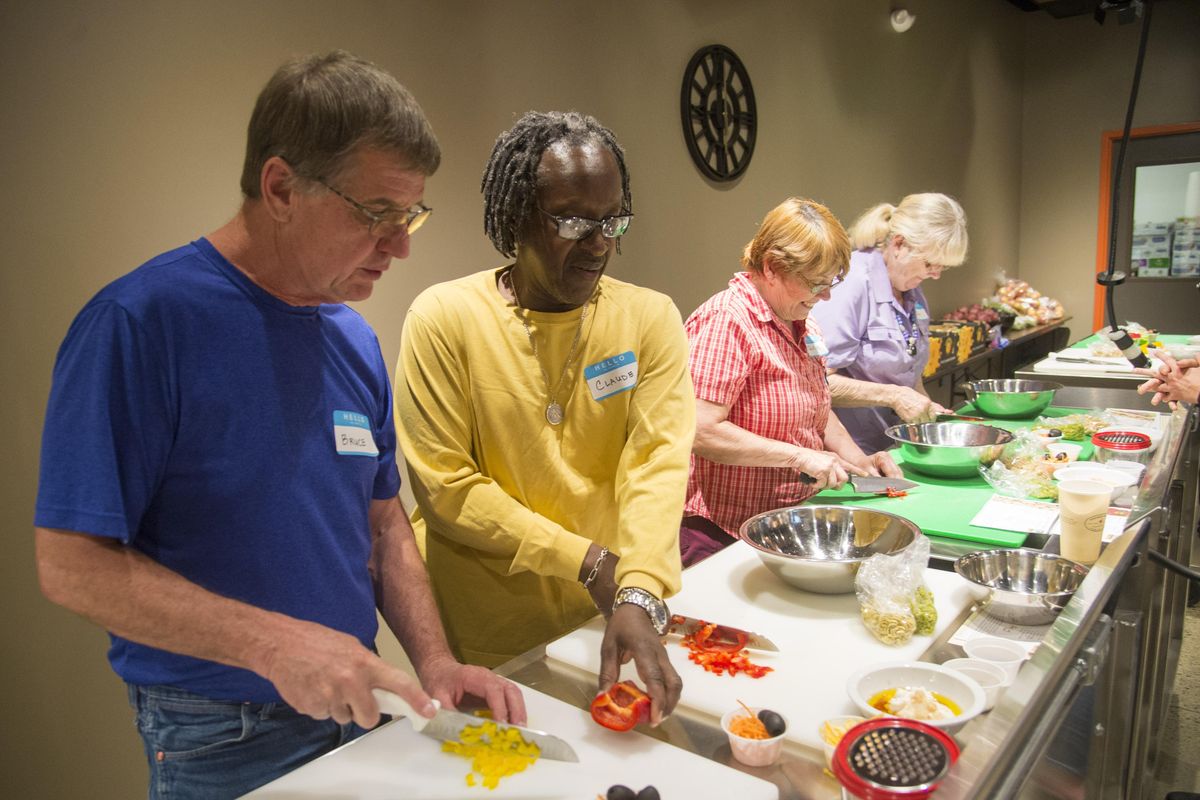Second Harvest cooking classes help build skills, health and community

It’s 5 p.m. on a Wednesday and Jandyl Doak is directing volunteers, answering questions and peeling red beets into one of the sinks in a streamlined kitchen reminiscent of a Food Network cooking show.
Doak, kitchen manager at Second Harvest’s food bank at 1234 E. Front Ave., has been running the community kitchen since October 2015 when it opened.
Although people receive food through organizations like Second Harvest, there’s still a high incidence of diet-related illnesses such as obesity, heart disease and diabetes among low-income populations.
Doak, who has more than 40 years of experience in the food industry, said one of the main goals of the cooking classes is to teach cooking from scratch.
“We concentrate on food that the food bank has in the warehouse, and we stay away from processed foods,” Doak said. “We also try to increase awareness of health and nutritional values of cooking from scratch.”
The group of six to eight volunteers and guest chefs have about 30 minutes before showtime – when 14 community members will file in to learn how to make two dishes: a beet salad and a pasta and split pea salad.
Cooking low-budget meals also tops the priority list. Typically, Doak said, meals on the weekly menus cost less than 50 cents per serving to make.
While she talked, several volunteers filled 14 personal containers with quinoa, grated carrots, lime juice, Dijon mustard and olive oil for the beet salad. Others worked in the back of the commercial kitchen preparing pasta and cooking peas for the pasta salad.
The kitchen itself, paid for with donor funds totaling $425,000, has portable cook stations, gleaming hard finishes, two convection ovens and a commercial dishwasher that takes only about two to three minutes per load.
Right on cue, men and women start filling the kitchen, chatting and obviously happy to be in attendance. Recipes, complete with nutritional information, are passed out while participants gather in front of the kitchen island where a guest chef demonstrates how to make tonight’s first recipe.
A big-screen TV is poised above for better visuals of the lesson.
The mood is casual and participants call out questions while Kevin Miller, a longtime food bank volunteer and tonight’s guest chef, moves through the instructions.
Miller mixes the dressing first, combining the vinegar, lime juice, honey, olive oil and spices while Doak provides commentary.
“We peeled all the beets for you,” she said. “We didn’t have any edamame or spinach in the warehouse today and if I don’t have it I can’t bring them to you. I recommend doing the dressing first … and the honey is local from Green Bluff.”
Doak tells the group to add and experiment at home with different ingredients.
“Raisins might be good in this dish. But if you don’t like something, you don’t have to put it in,” she added.
As Miller mixes the quinoa and other ingredients with the dressing, Doak talks about the virtues of quinoa.
“We call quinoa a mother grain,” she said. “It’s a whole grain and a complete protein. And it takes on the flavors of what you mix it with.”
With the beet salad tossed and set aside, Doak invites the group to begin the process of grating the beets at their cook stations.
Group members chat easily with one another while their hands get stained a deep red. Beets fall sloppily from graters as comments are murmured.
“This is definitely building up my muscles,” someone said. “They’re really making us work for this salad,” another person added.
Doak tells the group that everyone will take home their own creations while the class will share the salads put together by the chef at the end of class.
Linda Betty, who has been attending the classes since late January, said she found out about the classes through another class on chronic pain management.
“This class has taught me how to cook beans and lentils which are 70 percent protein,” Betty said. “And I’ve quit drinking soda. I drink six bottles of water a day … so it seems to be working.”
Jackie Pederson and Jan Mueller, one of several members of the Red Hat Society from Hillyard in attendance, said they have both learned how to use vegetables and lentils they never considered cooking with before.
“We’ve learned a lot about spices, too,” Mueller said. “My mother was actually a cook but she didn’t let me do anything in the kitchen while I was growing up. After I got married I had to learn how to cook mostly from my older sister.”
“I would not have thought to use split peas in a salad,” Pederson said. Both women agreed that the best part of the classes was having fun and interacting with other community members.
As the group cleaned up, volunteers distributed the ingredients for the next recipe, which went quickly since the pasta and split peas had been precooked.
The ambient noise and chatter grew louder as the group sat down together to taste the salads and socialize as the evening class drew to a close.
Doak and other volunteers joined in and answered questions and encouraged people to bring recipes to the next class.
In 2015, Second Harvest food bank provided 27 million pounds of food to 250 outlets in 26 counties in Eastern Washington and North Idaho, said Julie Humphreys, donor relations manager at the food bank.
“People think of a food bank only having mac and cheese, but 50 percent of what the food bank resources and distributes is fresh produce,” Humphreys said.
The goal of the classes, she said, is to help people stretch their food budget.
“We want to move more people from hunger to health,” she added. “We have a role in making sure we’re (providing) good food. And we’re making a difference in the health of the community.”